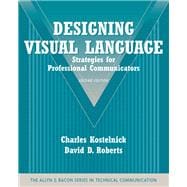
Note: Supplemental materials are not guaranteed with Rental or Used book purchases.
Purchase Benefits
What is included with this book?
Foreword by the Series Editor
Preface
PART 1 INTEGRATED COMMUNICATION
Chapter 1: Rhetorical Background
Introduction to Visual Rhetoric
It Depends: The Importance of the Rhetorical Situation
A Scenario for Applying Visual Rhetoric
How Fred’s Document Responds Visually to the Rhetorical Situation
Large-Scale Responses to Audience, Purpose, and Context
Local-Level Responses to Audience, Purpose, and Context
Summing Up Fred’s Design Decisions
Visual/Verbal Cognates
Arrangement
Emphasis
Clarity
Conciseness
Tone
Ethos
Interdependence of the Cognate Strategies
Process Example–Mapleton Center
Understanding the Rhetorical Situation
Invention
Revision
Visual Editing
What Can We Learn from Fred’s Process?
Conventions–What Readers Expect
Verbal Conventions
Visual Conventions
Visual Discourse Communities
Fred Noonan’s Use of Conventions
Some Basic Principles of Conventions
Acquiring the Language of Visual Conventions
Conclusion
Notes
References
Exercises
Chapter 2: Perception and Design
Introduction to Perception Issues
Perception Requires Thinking
We See Images within a Visual Field
Gestalt Principles of Design
Figure—Ground Contrast
Degrading Figure—Ground with Visual Noise
Grouping: Making the Parts Cohere
Patterns: Creating Groups across the Communication
Using Gestalt Principles to Respond to the Rhetorical Situation
Empirical Research as a Design Tool
Universal Research
Contextual Research
Conclusion
Notes
References
Exercises
Assignments
Chapter 3: Visual Analysis
Introduction to Visual Analysis
The Visual Vocabulary of Professional Communication
ATaxonomy for Visual Vocabulary
Intra-Level Design: Linear Components
Inter-Level Design: Fields and Nonlinear Components
Extra-Level Design: Data Displays, Pictures, Icons, and Symbols
Supra-Level Design: The Whole Communication
Each Communication Uniquely Combines Elements from the Matrix
Analyzing Visual Vocabulary Rhetorically
Analysis of the Visco Manufacturing Bunk Bed Instructions
Conclusion
Notes
References
Exercises
Assignment
PART 2 TEXT DESIGN
Chapter 4: Linear Components
Introduction to Linear Components
Process Example–Linear Components
Analyzing the Rhetorical Situation
Invention
Revision
Visual Editing
Vocabulary of Linear Components
Textual Elements
Spatial Elements
Graphic Elements
Synergy of the Coding Modes
Applying the Cognate Strategies
Arrangement
Emphasis
Clarity
Conciseness
Tone
Ethos
Interdependence of the Cognate Strategies
Notes
References
Exercises
Assignments
Chapter 5: Text Fields
Introduction to Text Fields
Process Example–Text Fields
Analyzing the Rhetorical Situation
Invention
Revision
Visual Editing
Vocabulary of Text Fields
Textual Elements
Spatial Elements
Graphic Elements
Synergy of the Coding Modes
Applying the Cognate Strategies
Arrangement
Emphasis
Clarity
Conciseness
Tone
Ethos
Interdependence of the Cognate Strategies
Genealogy Service Web Page
Notes
References
Exercises
Assignments
Chapter 6: Nonlinear Components
Introduction to Nonlinear Components
Process Example–Nonlinear Components
Analyzing the Rhetorical Situation
Invention
Revision
Visual Editing
Vocabulary of Nonlinear Components
Textual Elements
Spatial Elements
Graphic Elements
Synergy of the Coding Modes
Applying the Cognate Strategies
Arrangement
Emphasis
Clarity
Conciseness
Tone
Ethos
Interdependence of the Cognate Strategies
Notes
References
Exercises
Assignments
PART 3 EXTRA-LEVEL DESIGN
Chapter 7: Data Displays
Introduction to Data Displays
Process Example–Data Displays
Analyzing the Rhetorical Situation
Invention
Revision
Visual Editing
Vocabulary of Data Displays
Textual Elements
Spatial Elements
Graphic Elements
Synergy of the Coding Modes
Applying the Cognate Strategies
Arrangement
Emphasis
Clarity
Conciseness
Tone
Ethos
Interdependence of the Cognate Strategies
Notes
References
Exercises
Assignments
Chapter 8: Pictures
Introduction to Designing Pictures
Process Example–Pictures
Analyzing the Rhetorical Situation
Invention
Revision
Visual Editing
Vocabulary of Pictures
Textual Elements
Spatial Elements
Graphic Elements
Synergy of the Coding Modes
Applying the Cognate Strategies
Arrangement
Emphasis
Clarity
Conciseness
Tone
Ethos
Interdependence of the Cognate Strategies
Notes
References
Exercises
Assignments
PART 4 DOCUMENT DESIGN
Chapter 9: Supra-Level Elements: Designing for Usability
Introduction to Supra-Level Elements
Process Example–Supra-Level Elements
Analyzing the Rhetorical Situation
Invention
Revision
Visual Editing
Vocabulary of Supra-Level Elements
Textual Elements
Spatial Elements
Graphic Elements
Synergy of the Coding Modes
Applying the Cognate Strategies
Arrangement
Emphasis ur
Clarity
Conciseness
Tone
Ethos
Interdependence of the Cognate Strategies
Real Estate Packet
National Park Service Web Site
Notes
References
Exercises
Assignments
Glossary
Rhetorical Terms
Visual Vocabulary
Credits
Index
The New copy of this book will include any supplemental materials advertised. Please check the title of the book to determine if it should include any access cards, study guides, lab manuals, CDs, etc.
The Used, Rental and eBook copies of this book are not guaranteed to include any supplemental materials. Typically, only the book itself is included. This is true even if the title states it includes any access cards, study guides, lab manuals, CDs, etc.